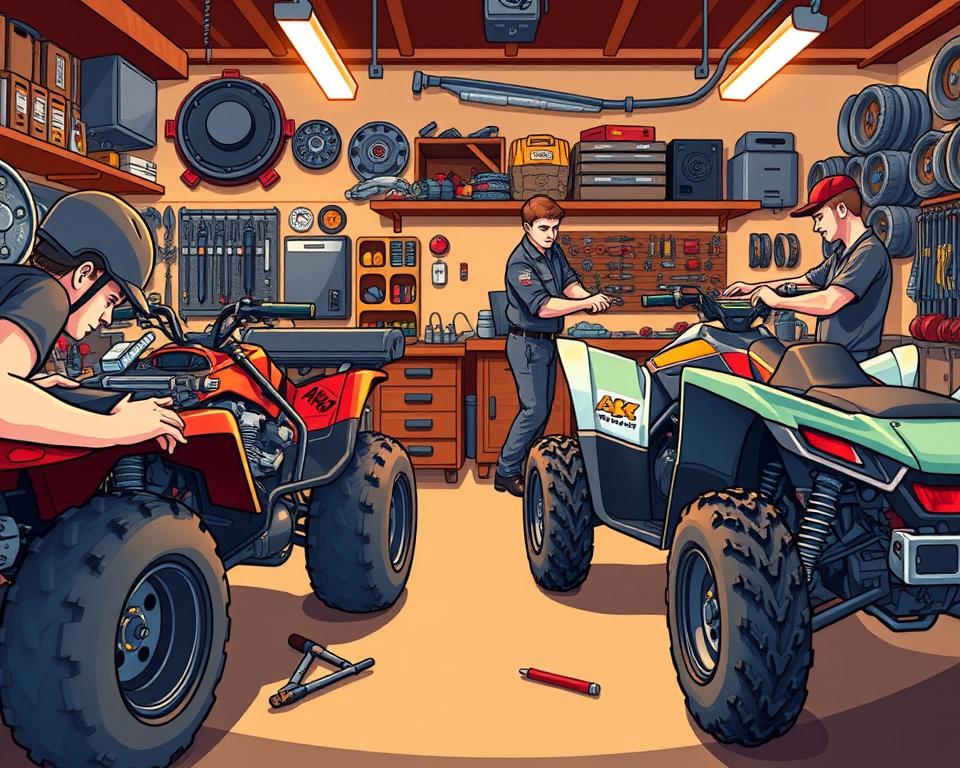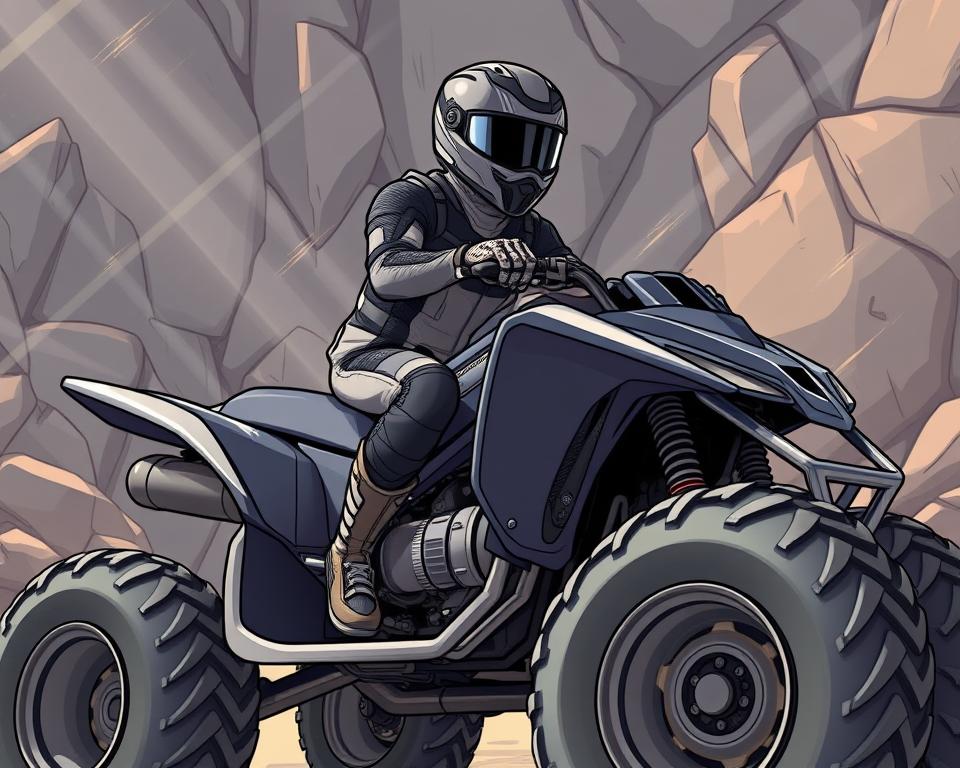Avoiding ATV/UTV Gearing Mistakes for Newbies
Have you heard that nearly 40% of new ATV and UTV owners face gear selection issues within their first year? Such data emphasizes how critical gear ratios are for novice riders. It’s not just about performance; it’s also about safety on the trails. In this guide, we cover typical errors, upkeep tips, and pro 2023 Can Am defender hd9 lift kit recommendations for better trail experiences.
Main Points

- Knowing gear ratios is crucial for peak off-road power.
- Common gearing oversights can lead to safety risks on the trails.
- Regular maintenance is key to preventing UTV transmission issues.
- Smart gear choices transform your outdoor rides.
- Applying service recommendations increases longevity.
Understanding ATV and UTV Gear Ratios
Gear ratios are vital for the performance of ATVs and UTVs. They govern both top speed and hauling capacity. This controls how quickly you get up to speed and tow trailers. By picking specific ratios, you tailor your ride for drag, trail, or work.
Picking the correct ratio optimizes power delivery. Excessively low gearing reduces hill-climbing pull. Overgearing sacrifices quickness for top-end speed.
Many enthusiasts use gear reduction to enhance handling and adaptability across different terrains. Ratio mods shape how your rig behaves off-road. It lets you balance acceleration with pulling force. Finding the sweet spot in gearing enhances ride quality and fuel economy.
Common Gearing Oversights for New ATV/UTV Owners
Correct gearing secures top output and trail safety. Many new owners overlook critical aspects of gear selection. Knowing what happens when you misgear and how to fix it transforms your experience. And it sidesteps needless breakdowns.
Impact of Incorrect Gear Selection
Wrong ratios threaten stability and component life. The wrong gear can slow down acceleration, affect braking, and cause excessive wear. These mishaps compromise safety for all on and off board. Adhering to service guidelines prevents such failures.
Choosing the Right Gear for Terrain
Different terrains need different gearing for efficient performance. Climbing requires low-end grunt from smaller ratios. Flats call for taller ratios to boost top-end. Soft ground demands careful gear choice for grip. Understanding trail types secures fun and safety.
The Importance of Proper ATV Maintenance
Scheduled service avoids surprises on the trail. Adhering to care guides prevents sudden failures and enhances safety. A smart maintenance regimen targets gearbox longevity.
Regular Inspection and Maintenance
A thorough inspection list catches troubles before they grow. Routinely examine gearbox teeth, brake pads, rubber, and belts. Integrating inspections into your schedule boosts reliability. Here are some critical inspection points to remember:
- Check gear mesh and teeth condition.
- Check for loose bolts or connections.
- Check master cylinder and calipers for leaks.
- Inspect tire pressure and tread depth.
- Check wiring and connectors for rust.
Fluid Changes and Gear Health
Clean fluids keep transmissions and differentials happy. Routine fluid swaps avoid sludge and varnish. Fresh oil cuts wear and heat for lasting components. Using this method secures dependable function and fewer breakdowns.
| Fluid Type | Recommended Change Interval | Benefits of Regular Change |
|---|---|---|
| Engine Oil | Every 50-100 hours | Cuts friction and boosts power |
| Gear Oil | Every 100-200 hours | Improves shifting, minimizes gear damage |
| Antifreeze | Annually | Stops boil-overs and freezes |
By following these guidelines, enthusiasts can enjoy their rides without worrying about mechanical failures. This makes every journey more enjoyable.
Common ATV Gear Shifting Problems
New ATV riders often face challenges with gear shifting. Learning silky shift methods transforms your ride. It reduces frustration on the trails. Synchronizing engine speed and clutch engagement stops misshifts.
Learning to Shift Smoothly
Honing silky shift skills takes deliberate training. Begin by listening to your motor’s cadence. Gentle shifts spare your gearbox and extend service life. Blending throttle with clutch release ensures seamless shifts.
Rehearse gear changes in a safe area before heading out. Apply minimal throttle for smooth transitions.
Recognizing Signs of Gear Issues
Catching faults early saves time and money. Listen for unusual sounds like grinding or popping, which may mean gears aren’t engaging right. Difficulty shifting can also signal problems that need quick attention. Spotting these signs early can prevent major damage and ensure a safer ride. Correcting misgears sustains reliability and your enjoyment.
Understanding UTV Transmission Issues
Dealing with UTV transmission problems can be tough, but knowing the common issues is vital for troubleshooting. Frequent complaints include gears that pop out and strange whines. Here we examine usual faults and outline a step-by-step fix plan. Drawing on proven UTV repair protocols.
Diagnosing Common Problems
Noticing early clues saves you from expensive repairs. Common issues include:
- Gears that pop out under load, risking accidents.
- Unusual sounds, such as grinding or whining, indicating mechanical damage.
- Signs of fluid seepage that threaten gearbox health.
Routine checks uncover faults early. It lets you fix faults before they worsen. Overlooking warnings costs more in the long run.
Solutions for Troubleshooting UTV Transmissions
Repairing gearbox problems calls for methodical steps. Follow these steps for effective troubleshooting:
- Verify oil levels and refill as needed.
- Inspect pan and seals for drips.
- Open housing to check bearings and gears.
- Drive through each gear step-by-step and note any skips.
- Consult the owner’s manual for specific diagnostics related to your model.
Following a reputable repair manual simplifies diagnosis. Understanding gear mechanics is key for any UTV owner. It greatly enhances your vehicle’s longevity and efficiency.
ATV Clutch Adjustments and Their Benefits
Proper ATV clutch adjustments are key to a great riding experience. Bad clutch setup leads to gear grind and confusion. Frequent tuning enhances clutch grip and shift precision.
Fine-tuning clutch engagement matters. Correctly calibrated clutches enable flawless transitions. That boosts throttle response and enjoyment in every gear.
Skipping clutch care leads to early failures and poor shifts. Regular tuning keeps shifts sharp and the motor lively. All riders benefit from clutch care to maintain top performance.
Mastering the Art of Gear Shifting
Becoming adept at shifts transforms your off-road sessions. It requires knowledge of your vehicle’s mechanics and developing a keen sense of timing and spatial awareness. Rookies need to practice gear timing. A steady shift rhythm yields cleaner transitions and more power.
Skillful shifting comes from drilling in diverse environments. Understanding when to shift gears based on terrain type enhances control and safety. For instance, shifting down when approaching a steep hill helps maintain power and stability.
- Practice shifting at low speeds to build confidence.
- Note engine tone and drivetrain reaction.
- Advance to tougher conditions to refine technique.
Tuning into your ATV’s feedback is key to shift mastery. Heed revs and shakes to know shift points. This helps determine the optimal moments to shift. Such intuitive understanding leads to proficient gear shifting, making your ride more enjoyable.
Best Practices for UTV Gear Selector Problems
Managing UTV gear selector problems demands a proactive maintenance and diagnostic approach. Frequent selector checks prevent surprises. Perfecting selector methods wards off glitches. Inspect link rods and fluid status as part of every service.
At the first sign of trouble, clear debris from the shifter. Clunks or rattles can signal a loose linkage. A quick tighten or lube can restore function. An organized maintenance schedule helps manage wear and tear.
Logging selector behavior in varied rides highlights issues. These best practices not only extend the gear selector’s life but also make riding safer and more enjoyable.
Tips for Enhancing Gear Performance
Achieving top drivetrain function demands regular attention. Routine service boosts ATV efficiency. Monitor fluids, look for damage, and fine-tune as required. Catching nicks before they worsen saves you big bucks.
Picking ideal ratios unlocks quicker revs and seamless cruisin’. Knowing trail types steers your ratio choices. It influences your launch and maximum velocity. Partnering with trusted makers like American Off-Roads for UTV performance enhancements adds power and reliability.
Applying gear performance tips across tires, shocks, and load balance boosts efficiency. Making these adjustments ensures that both ATVs and UTVs handle better in challenging environments. This leads to a more enjoyable riding experience. These steps ensure fearless exploration and maximum excitement on the trail.
In Closing
Getting your gears right is the key to speed and security. Matching gears to ground types transforms your adventure. Dodging typical pitfalls and choosing wisely delivers memorable, safe outings.
No less crucial is keeping your drivetrain in top trim. Regular checks and upkeep are key to avoiding problems and extending your vehicle’s life. Adequate maintenance enhances function and safeguards adventures across any terrain.
Merging smart ratio choice and regular upkeep yields the best off-road enjoyment. Embracing these tips sets the stage for countless epic journeys.
FAQ
Standard gear ratios on off-road rigs?
ATVs and UTVs have gear ratios that vary widely, depending on the model. Typical ratios lie within the 3-to-5 range. Low-end ratios yield higher pulling power. Taller ratios boost runway speed on level ground.
How to spot unsuitable gearing?
Misgearing risks unstable handling, rev overload, or sluggish starts. Different grounds need dedicated ratios to maintain traction and speed.
How to know when your machine needs service?
Head off issues if shifts go crunchy, the box hums, oil drips, or power falls off. Scheduling drivetrain inspections stops big failures.
Recommended fluid change intervals?
Aim for a fluid swap between 1,500–2,500 miles or annually, whichever comes first. Fresh fluids promote crisp shifts and gearbox longevity.
Best practices for flawless shifts?
Sync your revs and clutch for seamless gear changes. Feather the clutch up while winding the throttle for a perfect match.
Steps to diagnose gearbox problems?
First, inspect oil, then note any unusual gearbox sounds. Inspect the transmission fluid level and condition. Next, test-drive at varied speeds to see how it shifts.
Why adjust your ATV clutch?
Well-set clutches ensure crisp gear changes. Incorrect clutch setup strains the gearbox and causes sticky shifts.
How can I improve my gear performance on different terrains?
Test multiple gearing options and look into quality mods by American Off-Roads. Regular maintenance, such as checking gear health and fluid levels, also enhances performance.
When your UTV shifter sticks?
Regular inspections and routine maintenance are key. For jams or mis-engagements, follow your manual’s diagnostic steps.
Rookie gearing errors to dodge?
Rookies tend to ignore ratio basics, delay upkeep, or misgear for mud, rock, or hills. These mistakes hamper performance and raise the chance of mishaps.


